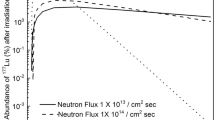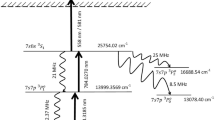Abstract
The cesium isotope 135Cs has an extremely long half-life (τ1/2 = 2.3 · 106 y) and its high water solubility leads to the anxiety of exudation to ground water during geological disposal. Such a LLFP 135Cs would be converted into 136Cs (Its half-life is 13.16 d and it becomes stable 136Ba) by neutron capture reaction. However intermingling 133Cs of which the natural abundance is 100% disturbs this nuclear converting reaction because 133Cs also absorbs neutrons and produces 135Cs again. For separating 135Cs from other cesium isotopes, laser-chemical isotope separation (LCIS) is believed to be suitable mainly due to the light absorption and emission stability. Isotope separation of alkali metal 85Rb/87Rb was successfully achieved, showed 23.9 of head separation factor by LCIS. The measured isotope shift of Cs D2 line is within the reach of available semiconductor lasers having emission line width of less than 1 MHz, which shows that the selective excitation of 135Cs may turn to be possible. It is known that cesium excited to the 62P3/2 state may forms cesium hydride while ground-state cesium does not. Therefore if the lifetime of 62P3/2 state is sufficiently longer than the inverse rate of the chemical reaction, 135Cs can be extracted as cesium hydride. Applicability of the Doppler-free two-photon absorption method for selective excitation and further evaluation on Rydberg states and ionization should be investigated.
Similar content being viewed by others
References
P. Wydler, L. H. Baetsle, Closing the Nuclear Fuel cycle: Issues and Perspectives, Actinide and Fission Product Partitioning and Transmutation, pp. 31–49, EUR 19783 EN OECD/NEA report (2001).
D. C. Wade, Safety Consideration in Design of Fast Spectrum ADS for Transuranic or Minor Actinides Burning: A Status Report on Activities of the OECD/NEA Expert Group Overview Paper, Actinide and Fission Product Partitioning and Transmutation, pp. 95–115, EUR 19783 EN OECD/NEA report (2001).
T. Katoh, S. Nakamura, H. Harada, Y. Hatsukawa, N. Shinohara, K. Hata, K. Kobayashi, S. Motoishi, M. Tanase, J. Nucl. Sci. Technol., 36 (1999) 635 and references in this paper.
Hideyuki Funasaka, Yoshikazu Koma, Koji Sato, Yasuo Nakajima, Hiroki Shiotani, Tatsuya Higuchi, Takashi Namba, Waste Management Implications of Advanced Fuel Cycle Systems using Fast Reactors (FR), WM’06 Conference, Feb. 26–Mar. 2, 2006, Tucson, AZ.
Hiroki Shiotani, Hirotsugu Kawasaki, Kyoko Mukaida, Kiyoshi Ono, The Multidimensional Evaluation on FR Cycle Systems (The FS Phase II Evaluation), Proceedings of GLOBAL 2005, Tsukuba, Japan, Oct. 9–13, Paper No. 485 (2005).
Japan Atomic Energy Agency and The Japan Atomic Power Company, Phase II Final Report Feasibility Study on Commercialized Fast Reactor Systems Executive Summary, March 2006.
Japan Nuclear Cycle Development Institute (JNC), Supporting Report 3 (Safety Assesment of the Geological Disposal System) of H12: Project to Establish the Scientific and Technical Basis for HLW Disposal in Japan, WM’06 Conference, Nov. 1999.
P. A. Bokhan, V. V. Buchanov, N. V. Fateev, M. M. Kalugin, M. A. Kazaryan, A. M. Prokhorov, D. E. Zakrevskii, Laser Isotope Separation in Atomic Vapor, Wiley-VCH, Berlin, August 2006, ISBN 3-527-40621-2.
A. Badalyan, V. Chaltykyan, Yasuhiko Fujii, Yu. Malakyan, Masaki Ozawa, A. Papoyan, S. Shmavonyan, Progress in Nuclear Energy, 47, Nos 1–4 (2005) 389.
V. Chaltykyan, Yu. Malakyan, S. Shmavonyan, A. Papoyan, J. Phys. B: At. Mol. Opt. Phys., 37 (2004) 3735.
M. Motzkus, G. Pichler, K. L. Kompa, P. Hering, Journal of Chemical Physics, 108 (No. 22) (1998) 9291.
A. Badalyan, V. Chaltykyan, G. Grigoryan, A. Papoyan, S. Shmavonyan, M. Movsessian, Eur. Phys. J. D, 37 (2006) 157.
W. Demtroder, Laser Spectroscopy Basic Concepts and Instrumentation, Second Corrected Printing, Springer-Verlag, Berlin, Heideberg, 1982.
A. Tam, G. Moe, W. Happer, Particle Formation by resonant laser Light in Alkali-Metal Vapor, Physical Review letters, 35 (No. 24) (1975) 1630.
Masaki Ozawa, Tatsuya Suzuki, Shinichi Koyama, Hiroshi Akatsuka, Hitoshi Mimura, Yasuhiko Fujii, Progress in Nuclear Energy, 50 (2008) 476, Elsevier.
Author information
Authors and Affiliations
Corresponding author
Rights and permissions
About this article
Cite this article
Chaltikyan, V., Papoyan, A., Oshita, H. et al. Perspectives of laser-chemical isotope separation of a long-lived fission product: cesium-135. J Radioanal Nucl Chem 280, 343–352 (2009). https://doi.org/10.1007/s10967-009-0525-5
Received:
Published:
Issue Date:
DOI: https://doi.org/10.1007/s10967-009-0525-5




